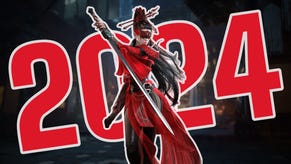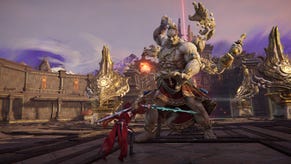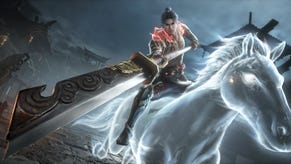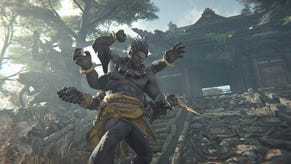How do you keep a free-to-play game alive? We asked one of the most popular battle royales on Steam, that boasts over 40 million players
Naraka Bladepoint is one of gaming's most recent free-to-play success stories, and 24 Entertainment is keen to keep it that way. Here's how it plans to do it.
The landscape of free-to-play games is competitive - literally. From MOBAs, Hero Shooters and massive gacha RPGs, to Battle Royales and whatever Fall Guys is, there’s no shortage of ways to scratch that PvP itch with no upfront investment outside of your time (and the power to run your console, and the money to buy your TV, and to buy Pickled Onion Monster Munch to snack on…)
With such a crowded landscape, that only gets busier as more new releases add to the pile every month, successful F2P games need to strike a delicate balance to stand out and stay on top. But when something’s “free”, it’s another task entirely to make that something worthwhile, particularly in the long term. So I wanted to find out some of what goes into keeping a free-to-play game relevant and thriving over multiple years.
Naraka: Bladepoint is a game I’ve been interested in for a while, with a fervid fanbase of hundreds of thousands of global players every day on Steam alone. A big portion of its player base is in China, which I found out when I visited the Naraka J Cup World Championships last year to try and understand its appeal more, but its developer, 24 Entertainment, definitely has designs on expanding its reach in different territories too.
As I found out at the World Championships, Naraka: Bladepoint does a few things differently.
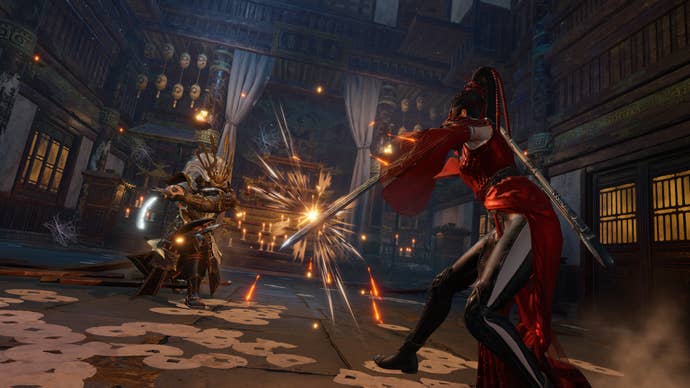
Firstly, it draws on Chinese culture and history with a more realistic graphical style than the likes of Genshin Impact and Wuthering Waves, offering something that’s authentically different from Western games without feeling as derivative as the gachas. It also adds its own spin on the Battle Royale genre with a melee combat system which calls to mind the martial arts movies that remain such a key cultural touchstone for Chinese media in the world.
However, I feel like its main differentiator is the uncommon depth and complexity to its combat mechanics, which Naraka pros liken more to a fighting game than a Battle Royale. With long, specific combo strings with a high skill-gap and technical focus on execution, many melee games - especially those with “one-button combat” - feel like button mashers, whereas there’s a skilful nuance to reading the flow of combat in Naraka that’s difficult to master and can be off-putting for new players if they’re immediately dropped into a lobbyful of veterans.
Ironically, it seems like Naraka: Bladepoint has tried to overcome this impenetrability by casting its net wider and recruiting familiar faces to bridge the gap.
“Initially, we decided to use the buyout model for sales, which was more of a conservative approach,” Fei Hoing, Lead Designer on Naraka: Bladepoint, says. “However, at this time last year, we already had the trust of over 20 million players. We have adopted an open experience to attract and enhance the game, and we believe this is definitely the right choice. This approach has already brought in over 40 million players to Naraka: Bladepoint, as well as more high-quality user-generated content and more potential.

“The transition to free-to-play has lowered the barrier for players to participate in our game, attracting more players interested in trying out close-combat battle royale gameplay. Secondly, after the transition, Naraka: Bladepoint has continued to try various collaborative partnerships, such as with Nier, Bruce Lee, The Soul Land, and the announcements of collaborations with Tomb Raider and The Witcher 3: Wild Hunt at Naraka Fest Direct 2024, which have injected a lot of fresh blood into Naraka: Bladepoint.”
But it’s not simply about getting those people through the door with a smiling Geralt and an interesting concept then calling it a day. Naraka’s biggest challenge once it’s put itself in front of a potential fan is keeping them invested long enough to learn its mechanics, which 24 Entertainment feel is about showing genuine engagement with developing player experience and offering a diverse range of gameplay hooks.
“I believe the most important factor is listening to the players' voices, understanding their underlying needs, and knowing their demands in order to better optimize the game experience and innovate gameplay,” Fei Hoing explains.
“Seamless wall-running and grappling hooks are designed to provide a smooth chasing experience. The Rebirth charm is designed to give unexpectedly defeated players a second chance. The design of the Realm of Yang is to provide a place for players who enjoy pure 1v1 combat. High-risk air deliveries in FPS games are seen as less risky in close combat, so in subsequent updates, we transformed them into Spirit Well, areas that need to be captured to obtain rewards. After the game's launch, there have been many updates, and we have put a lot of effort into listening to players' voices. After understanding their demands, we carefully consider and further feed back into the game with targeted adjustments, which is also the charm of online games.

“We also rewarded old players who had previously paid for the game with the equivalent in-game currency and many exclusive skins, in order to let both new and old players feel our sincerity.”
However, with a high skill-gap game like Naraka, exclusively “listening” to the most dedicated sections of the player base can only deepen issues on the front of accessibility, risking leading to a more insular community. Rather than balance just for the hardest-core players, 24 Entertainment tends to give pro players arenas with specific restrictions around team compositions which effectively function as ban picks to shift the style of play.
“It's not just professional players, but also high-scoring players and those who are obsessed with researching combos, their focus is often different from the general public,” Fei Hoing says.
“We still pay more attention to the needs of the general users in terms of balance adjustments. For issues such as hero balance in the professional competition arena, we generally impose restrictions through the competition rules, for example, through rules that limit a single hero to be used by a player no more than 2 times.”
“Of course, the balance of characters in a game lays the foundation for its long-term development. This is why we allow players to experience new characters in the test server before they are officially launched and quickly adjust and optimize based on player feedback. However, new content is also essential because it is the best gift a game can give back to its players. New modes, weapons, characters, costumes, etc., not only allow players to experience the ongoing efforts of the developers but also encourage players to continuously create interesting new content in the community.”
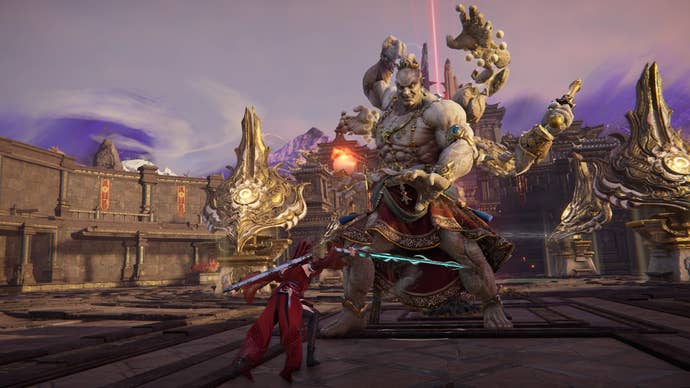
The most salient example of how 24 Entertainment incorporates new content in practice is with new characters. The most recent character in Naraka Bladepoint is Lyam Liu, a martial arts Magneto with the power to control metal, who’s a perfect example of the mixture of fantasy and traditional Chinese culture Naraka aims to highlight.
“Through this character, we hope to expand the lore of Naraka: Bladepoint, connecting the martial arts world with the historical court's political intrigue,” Fei Hoing explains. “Our heroes are generally developed by the copywriter first, who creates the character, appearance, and story background. Then, based on this content, the hero planner refines the hero's abilities, and these abilities are used to release skills. For example, Akos Hu is a child picked up from a tiger's den when he was young, then ‘tiger’ can be the source of his abilities, and skill design will also be based on the ‘tiger’ element.
“In terms of background, identity, and personality, Lyam Liu is derived from the ‘martial arts fanatic’ image in traditional Chinese martial arts culture. They have strict requirements on martial arts practice and cultivation, dedicating their lives to the process of continuously becoming stronger. Moreover, they are pure-hearted, with the pursuit of strength stemming from their internal drive rather than external evaluation. In fact, this is somewhat similar to the modern athletes' constant pursuit of surpassing themselves.
“In the worldview, the Lyam Liu family is on one hand part of the ‘martial arts world’. They are one of the five major families of the Wuji martial arts world. On the other hand, due to their innate affinity for metal elements - one of the five elements in Chinese fantasy and philosophical systems - their family has obtained mining, excavation, and business rights, becoming the ‘iron officials’ serving the court.”

In terms of gameplay, within the Naraka meta each character fulfils a certain role, but pro players and content creators often say that 24 Entertainment purposefully shakes up the gameplay by making new weapons very powerful and tuning new heroes to be some of the best characters in Naraka Bladepoint.
The previous new character, Shayol Wei, was a very strong defensive character, capable of absorbing hits with her Ultimate to effectively neutralize opposing teams and begin her own combos. It’s not a surprise then that Lyam Liu is suited to longer strings of combos and manipulating space, allowing him not only to act as a disruptor in these defensive situations, but also deal with the incredible movement capability of previously dominant characters like Hadi (another relatively recent addition).
“Based on player feedback, it is evident that [Lyam Liu] is very active in solo play,” Fei Hoing says. “His strengths lie in his ability to easily combine different weapons for a variety of long combo attacks. He also possesses excellent long-range attacks and control abilities, making him a valuable team player for focusing fire and disrupting opponents in duo and trio matches.
“Lyam is capable of executing a diverse range of long combo attacks, so heroes that provide an environment for extended combos are well-suited for teaming up with him, such as Yueshan, Tessa, Viper Ning, and Tianhai. Additionally, heroes like Ziping, who provide more error tolerance, are also suitable partners.

“During long combo attacks, he is most susceptible to being interrupted by control-type heroes, such as Tessa, Valda Cui, and Viper Ning.”
However, while tuning new characters to be strong in the meta certainly keeps it fresh, it can also lead to original heroes feeling weak in comparison, which is a massive problem when they’re the characters new players are on boarded with. To combat this, 24 Entertainment is committing to bringing each character up to the current level of the game soon.
“We will not completely redesign the heroes,” Fei Hoing summarizes. “But rather optimize the skills of most characters based on the merging of talents. In terms of strength, all heroes will be adjusted according to a unified standard, while the user experience will be optimized based on the pain points of each hero.”
Naraka Bladepoint is free-to-play on Steam, Xbox Series consoles and PlayStation. It contains microtransactions for outfits, skins and other customization items.


